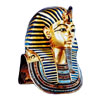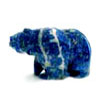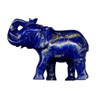- sale
- new items
- lovely beads
- wedding beads
- beads for teens
- for custom order
- newsletter
- recognition
- testimonials
- birthstones
- zodiac signs
- jewelry guide
SHOP BAG
![]() in your bag 0 items
in your bag 0 items
Lapis lazuli is a semi-precious stone prized since antiquity for its intense blue color. Lapis is a rock and not a mineral because it is made up from various other minerals. The main component of lapis lazuli is lazurite; it also contains calcite (white), sodalite (blue) and pyrite (metallic yellow), and some other constituents. The finest color is intense blue, lightly dusted with small flecks of golden pyrite.
Lapis is the Latin for "stone" and lazuli the genitive form of the Medieval Latin LAZULUM, which is from the Arabic LAZAWARD, which is ultimately from the Persian LAJWARD, the name of a place where lapis lazuli was mined. The name of the place came to be associated with the stone mined there and eventually, with its color. The English word "azure", the Spanish and Portuguese "azul", and the Italian "azzurro" are cognates. As a whole, lapis lazuli means "stone of azure".

The best lapis lazuli is found in limestone in the Kokcha river valley of Badakhshan province in northeastern Afghanistan, and these deposits in the mines of Sar-e-Sang have been worked for more than 6,000 years. Badakhshan was the source of lapis for the ancient Egyptian and Mesopotamian civilizations, as well as the later Greek and Roman. In addition to the Afghan deposits, lapis has been found in the Andes in Chile, where it is usually pale rather than deep blue, in the Lake Baikal region of Russia, Angola, Burma, Pakistan, USA (California and Colorado), Canada and India.

In ancient Egypt lapis lazuli was a favorite stone for amulets and ornaments such as scarabs; it was also used by the Assyrians and Babylonians for seals. In ancient times, lapis lazuli was known as sapphire, which is the name that is used today for the blue corundum variety sapphire. It appears to have been the sapphire of ancient writers because Pliny refers to sapphirus as a stone sprinkled with specks of gold. Lapis jewelry has been found at excavations of the Predynastic Egyptian site Naqada (3300-3100 B.C.), and powdered lapis was used as eyeshadow by Cleopatra herself. The ancient royal Sumerian tombs of Ur, located near the Euphrates River in lower Iraq, contained more than 6000 beautifully executed lapis lazuli statuettes of birds, deers, and rodents as well as dishes, beads, and cylinder seals.
Many of the blues in painting from medieval Illuminated manuscripts to Renaissance panels were derived from lapis lazuli. Ground to a powder and processed to remove impurities and isolate the component lazurite, it forms the pigment ultramarine. Since the synthetic version of ultramarine was discovered in the 19th century (along with other 19th century blues, such as cobalt blue), production and use of the natural variety has almost ceased.


